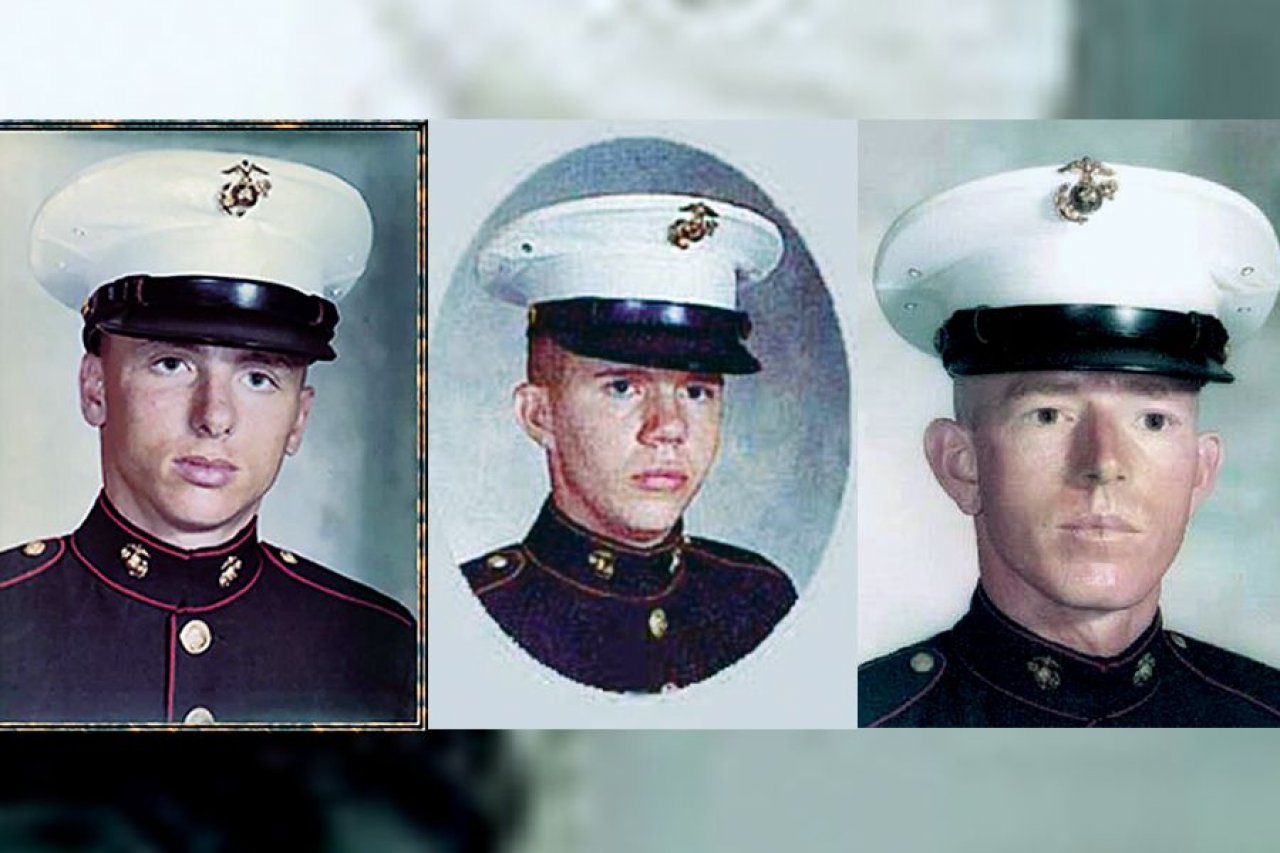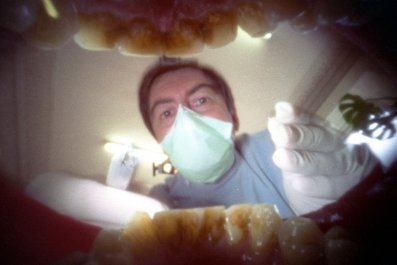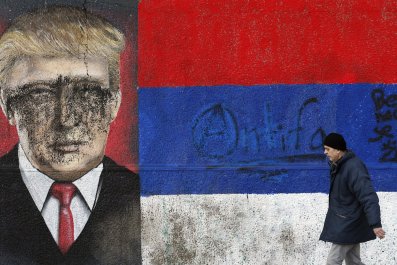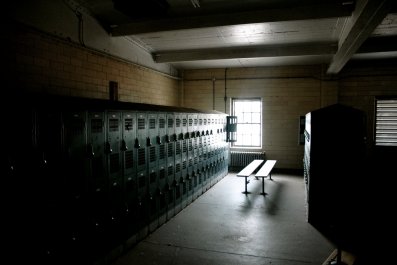Tap, tap tap. Scott Standfast knocked on the door again. He'd been at it for several minutes, standing in front of a one-story brick house in Niceville, Florida, on a warm, dry day in November 2015. The then-59-year-old former Marine and his wife had driven more than 11 hours to get here, hoping to answer a question that's haunted him for 40 years. He knocked again. This time, harder. Boom, boom, boom! Still no answer.
About four decades ago, Standfast fought in the last battle of the Vietnam War, and his memory of it is sharp—from the location of enemy positions to the smothering jungle foliage. But it's not what he remembers that troubles him; it's what he can't recall about that traumatic day. He's tried everything. In 2015, he even joined a group of veterans for a trip back to the battlefield where they met their former enemies. Some shook hands, trying to forgive and move on. The experience helped but not enough. "It's blocked out," he tells me on the phone, choking up. "I'm sorry."
On May 15, 1975, Standfast, then a lance corporal and squad leader with an infantry battalion for the U.S. Marine Corps, fought in what's known as the Mayaguez Incident, a bloody, mostly forgotten battle on a Cambodian island commonly referred to as Koh Tang. It began when Khmer Rouge soldiers captured a U.S. container ship and its crew off the coast of Cambodia. The American military came to their rescue, but dozens of service members died during the operation. President Gerald Ford hailed the mission as a resounding success, but in the chaos of their exit, three Marines went missing: Joseph Hargrove, Gary Hall and Danny Marshall. The Marines later investigated and said that the three had disobeyed orders by not making it to the helicopters in time and that they were likely killed before the last U.S. chopper lifted off.
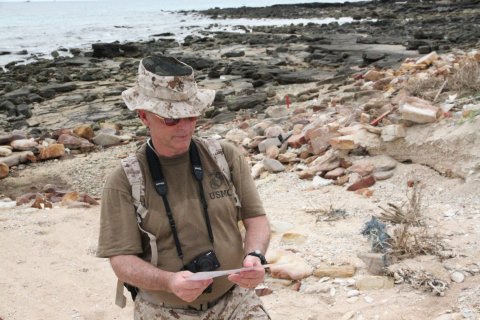
After the incident, Ford enjoyed one of the largest spikes in presidential approval ratings, but the trauma of the battle and the disappearance of their fellow servicemen gnawed at Marines like Standfast. The three lost men were members of a machine gun team assigned to his squad. They were supposed to be sitting next to him in that final helicopter out. Instead, they had vanished.
Standfast doesn't remember being told they were missing that night. He doesn't remember anyone lobbying to go back for them. He knows he went to the memorial service for his fallen comrades, but he can't remember that either. The last thing he recalls is his chopper touching down in darkness on an aircraft carrier. Everything after that is blank. Perhaps it's a way to protect himself from the pain. He manages to mostly keep that pain hidden, but there are signs of it beneath his hardened, jarhead façade. Sometimes he's friendly and easygoing; the next moment he's rigid and withdrawn.
He had come to Niceville because Cary Turner, a cousin of Hargrove's, had called weeks earlier with surprising news: A former Air Force controller claimed he knew what had happened to his cousin and to the other two Marines. Standfast immediately began to plan his trip.
Related: Navy SEAL's savior claims 'Lone Survivor' got It wrong
Now, as he stood in front of that closed door, knocking and waiting, he wondered if the call had been a hoax. Standfast spotted a neighbor, who told him that it was the right house and that the man was home. So he knocked again, waited some more. And then, after several minutes, the curtain over the window by the door moved, and a gray-haired man with dark-rimmed glasses cautiously peered out. Standfast showed him his veteran ID card and explained who he was and why he was there. He pleaded for the truth that had escaped him all these years.
The curtain closed. The knob turned. The door opened, and Standfast and his wife walked into the house.
Once inside, former Air Force Staff Sergeant Robert Velie told them everything he knew about the three men who had disappeared on the bloodstained shores of Koh Tang; the three men whose remains have officially never been found but whose names are among the last put on the Vietnam Veterans Memorial Wall in Washington, D.C.; the three men whose tragic disappearance remains one of the last enduring mysteries of one of America's most disastrous wars.
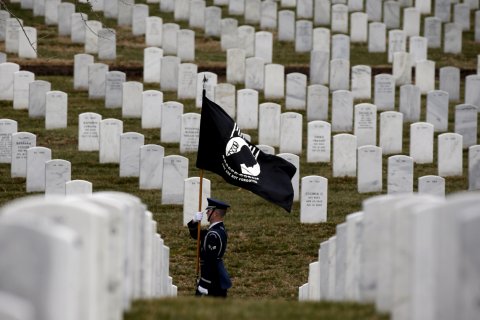
The POW Pawns
Few issues in America have been more contentious or painful than the fate of the thousands of U.S. servicemen who were imprisoned or went missing during the Vietnam War. In his book, Until the Last Man Comes Home, Michael Allen, associate professor of history at Northwestern University, points out that President Richard Nixon—a man who campaigned in 1968 on his "secret plan" to end the conflict—was among the first to politicize the issue, parading the wives of prisoners on television in 1969 to justify his expansion of the war. "We've got those liberal bastards on the run now!" he reportedly crowed.
The Nixon administration vowed the U.S. would never leave Vietnam until every last service member came home, and, Allen writes, it inflated the number of Americans possibly in captivity to undercut those arguing for a speedy withdrawal. This was a winning strategy until it suddenly turned on Nixon. As the war dragged on—and the Vietnamese continued to use American prisoners for their own cynical propaganda—these families began speaking out against the conflict, demanding that Washington bring their men home. "[The prisoners] became poster boys of American sacrifice in the Vietnam War," Allen tells Newsweek.
In January 1973, the U.S. ended its direct military combat operations in Vietnam, but the war over American POWs continued. Shortly after the peace accord was signed in Paris, less than half the number of U.S. servicemen the White House had said were missing or in captivity had been returned by the North Vietnamese, according to Allen. The Nixon administration maintained that every prisoner had been returned. But its earlier inflated claims left many families bitter and incredulous at a time when the Watergate scandal was already eroding trust in government. "That's when the myth of the left-behind POW starts to take off," says Allen.
Over the next two decades, these families continued to demand answers (and assign blame), which led to investigations and even congressional hearings. During the 1980s, these efforts were often exploited by lawmakers—mostly on the far right—to accuse their opponents of weakness, Allen says, and as POWs became a staple of popular culture through films such as Rambo and Missing in Action, the public became even more cynical about a government that had repeatedly lied about the Vietnam War, from the Gulf of Tonkin Incident to the fall of Saigon.

Meanwhile, researchers like Lynn O'Shea were trying to prove that U.S. servicemen were still being held. She unearthed the government's 1976 Project X study, which said as many as 57 Americans could still be in captivity in Southeast Asia—and the Tourison Memos, which said some American service members declared dead by the U.S. had made it into enemy custody alive. O'Shea also provided the most complete account to date of Operation Pocket Change, a 1981 plan by the Reagan administration to rescue POWs from Laos. (The operation was scuttled due to congressional leaks and poor intelligence provided by the CIA.)
Yet no one definitively answered the question of what happened to the missing men who had rushed to rescue the S.S. Mayaguez. The Marine Corps declined to comment for this story, but over the past five years, by making trips to Cambodia, reading thousands of pages of U.S. government documents and interviewing combatants on both sides as well as current Cambodian military officials, I've uncovered disturbing new details regarding what happened to those men—information the U.S. government has kept from their friends and families for decades.
Good Mourning, Koh Tang
On the afternoon of May 12, 1975, the Mayaguez, an American cargo ship, was traveling from Saigon (now Ho Chi Minh City, Vietnam) to Sattahip, Thailand, when Khmer Rouge forces in a skiff fired at it when it was two miles offshore from Cambodian territory. As the ship stopped, seven Khmer sailors carrying AK-47s and rocket-propelled grenade launchers climbed on board. The crew managed to send a distress signal, which was received by a private company in Jakarta, Indonesia, and forwarded to the U.S. Embassy there. Within hours, officials in Washington learned of the hijacking and scrambled the Air Force, dispatched the Navy and mobilized Marines from the jungles of Okinawa.
Navy pilots watched from above as Khmer Rouge gunmen anchored the Mayaguez near Koh Tang and took the crew toward the mainland. But American officials largely ignored this intelligence and continued to plan a rescue operation on the island. Defense officials estimated there were as many as 200 hardened Khmer Rouge fighters armed with heavy weapons there, but no one passed this information down to the Marines who'd been ordered to attack the island. They were told to expect between 20 and 40 old men and farmers.
Early in the morning of May 15, four American helicopters swooped toward the northern tip of Koh Tang, and the Khmer Rouge quickly shot two out of the sky. Both crashed on the beach or in the shallows, and a few survivors made it to the tree line. Others, some severely wounded, were forced to swim under withering fire out to sea, where they were rescued by U.S. servicemen on a small boat sent from a nearby destroyer. The other two choppers fared only slightly better—Khmer Rouge gunners damaged both of them as they tried to drop off Marines. One returned to the Thai coast for an emergency landing; the other limped out to sea where it crashed, killing one airman.
Eventually, however, 131 Marines, Navy corpsmen and airmen made it onto the island, and for 14 hours they battled Khmer Rouge soldiers in close quarters.
Shortly after noon, Standfast arrived with 100 reinforcements, including his machine gun team—Hargrove, Hall and Marshall. The fresh troops informed the Marines on the ground that an American destroyer had recovered the Mayaguez crew that morning, adrift in a fishing boat, and that Marines had seized the ship. Translation: They'd been sent into a raw firefight for no reason. Officials in Washington ordered a withdrawal, but planning and executing that would take time, so the Marines had to wait until the damaged fleet of helicopters could come to their rescue.
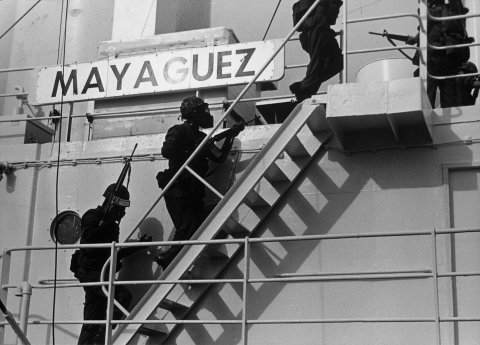
As a torrent of bullets flew through the air, Standfast set his machine gun team on the extreme right-hand side of the Marine position. Sergeant Carl Anderson set trip-flares in front of the team and checked the lines to make sure his fellow servicemen were OK, he says. American bombers then started pounding the jungle, and the shooting subsided as the Khmer Rouge retreated.
Yet as darkness fell and the rescue choppers approached, the Communists crawled back to their spider holes and launched another assault on the Americans. Air Force pilots braved heavy fire in barely functioning helicopters, coming in one at a time to rescue the Marines, who were trying to beat back the Communists. With fewer U.S. servicemen on the ground, however, the Khmer Rouge advanced. On the west beach, as more and more Americans climbed into helicopters, Captain James Davis took charge of the remaining soldiers. Some, like Hargrove, Hall and Marshall, he had never met before. At one point, Davis took to the airwaves to say they were minutes away from being overrun.
Before that could happen, he climbed into the last chopper. Some of the Marines on board that helicopter told the crew there were still men on the beach. The air crew asked Davis, the most senior officer on board, to weigh in, but he was relatively certain everyone had been picked up, according to Air Force radio transcripts.
For the next few hours, military officials repeated Davis's claims over and over—until they realized he was wrong.
Ghosts in the Radio
Air Force Staff Sergeant Robert Velie was behind his radio console aboard the EC-130E Airborne Battlefield Command and Control Center, a military transport aircraft with sophisticated communications gear. Velie and his team had coordinated the battle, communicating with the commanders, air support and men on the ground. As the last helicopter was leaving, Velie and company heard over the radio that all of the Marines had been picked up. They were directing the last few airstrikes on the island before heading home.
Just after 8:20 p.m., Velie's radio hissed, and he heard an American voice asking when the next chopper was coming back to get them. Velie was puzzled; he knew there were no more helicopters heading back to the island. In fact, there were gunships headed in, ready to hose it down. Velie asked the caller if he was at the last pickup site and why he hadn't boarded the chopper. "We were told to lay cover fire [for the choppers] and they'd come back for us," Velie recalls the man saying.
Velie immediately thought it was a Khmer Rouge trick to lure in more helicopters, so he asked the caller for the authentication code. The Marine didn't hesitate; he answered correctly with the proper response. Velie says his superior then told Navy commanders there were still Marines on the island. A short time later, the commanders responded: Davis, they said, had told them everyone was accounted for.

Velie's commander radioed a destroyer in the area, the U.S.S. Harold E. Holt. Someone on the Holt instructed him to have the abandoned Marines make their way out to sea, where they would attempt to pick them up. But the men, Velie says, didn't like that plan; they still believed a helicopter would come to their rescue.
The Marine Corps report on the disappearance of the three men states that one was a poor swimmer and the other two couldn't swim at all, so heading far out to sea in the dark would have been dangerous. Velie told the Marine on the radio that he and the others should immediately take cover, because the gunships were about to arrive. The Marine said, "Roger," and soon two gunships pummeled the island with cannon fire.
After the barrage, Velie called the Marine back. There was no answer.
'I Thought I Was at Fault'
Velie isn't the only one who disputes the Marine Corps version of what happened to those three servicemen. Private First Class David Wagner, among other Marines, told investigators the three gunners covered him as he loaded wounded men onto the helicopters—and said he even gave Hall ammunition.
Air Force Staff Sergeant Ray Buran Jr. remembers the Marines' call for help bolstering Velie's claim. "[A Marine] did talk to someone [on board Velie's aircraft]," he says. Buran was manning a different console on Velie's aircraft, so he was not privy to the conversation, but he recalls hearing that the Marines were being chased and taking heavy ground fire, which differs slightly from Velie's account.
Anderson, the last American to see the three alive, according to military reports, doesn't recall seeing them at the landing zone, but he does remember their call after the last chopper lifted off. He says he heard a recording of it in Okinawa, several days after the battle, while he was under investigation for leaving the Marines behind (he was cleared of responsibility). "There was a tape of [the Marines] that I thought the enemy had made," he says. (According to Velie, the Americans recorded all radio communications with Marines on the ground.) "It was definitely Hall, Marshall and Hargrove," Anderson adds. He can't remember what they said, but he didn't hear Cambodian voices on the tape, he says, and there was no evidence of coercion. "[The tape] got to me. I thought I was at fault."
With the three Marines possibly still alive but no longer responding, the U.S. military had a difficult decision to make. Velie says there were many possible reasons the Marines on the beach didn't get back on the radio. His aircraft could have moved out of their range. Or they had been wounded or forced to hide because Khmer Rouge fighters were nearby. Because of their poor swimming ability, he doubts they tried going out to sea. His aircraft stayed in the area until after midnight, hoping to make contact again, but the radio remained silent.
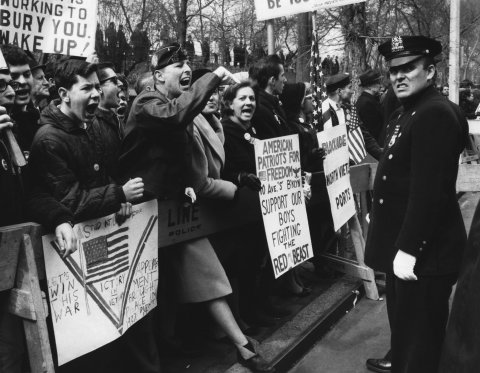
Davis died in 2012. But years earlier, he told CBS News he had volunteered to go back to the island, but his request was denied. Velie, Anderson and Buran agree that returning to Koh Tang would have been incredibly dangerous. "There were no resources [to go back for them]," Buran says referring to the damaged helicopters. "Everything was shot down or shot up."
There really was only one hope left for the missing machine gun team: the Navy SEALs.
Advocating Suicide
On the night of May 15, Tom Coulter, then a lieutenant and leader of Navy SEAL Team 1's Delta Platoon, arrived on the aircraft carrier U.S.S. Coral Sea while the smoke still hung above the Koh Tang battlefield. Coulter hadn't heard about that mysterious last radio call, but sailors on the Holt said there was "a problem with the head count." Coulter met with Navy Vice Admiral Robert Coogan, the Navy's on-scene commander, and their meeting quickly turned heated. Coogan wanted to drop fliers over Koh Tang announcing that the SEALs were coming, Coulter says, then send the men ashore, unarmed, during the day to retrieve "Marine bodies" that "may or may not be on the beach." Coulter thought Coogan was advocating suicide. "I told him we would not be taking that mission."
Coulter eventually persuaded the brass that the SEALs should plan their own mission. He suggested they go in armed and at night, to avoid being detected. He and his 13 men then headed to the Holt with two inflatable boats, and the destroyer turned back toward Koh Tang.
The hour was late, Coulter recalls, when he was called into Holt Commander Robert Peterson's quarters for a conference call with the White House. He doesn't think President Ford was on the call, and he can't be 100 percent certain, but he believes Coogan was on it, as was Secretary of Defense James Schlesinger and Secretary of State Henry Kissinger. "Someone on the call had an accent," he says, referring to the German-born Kissinger. They were canceling the SEAL rescue operation, Coulter recalls, because "the risk was too high." Kissinger did not respond to Newsweek requests seeking comment. Coogan; his superior at the Pacific Command, Admiral Noel Gayler; and Schlesinger are dead. Acting Joint Chiefs of Staff Chairman Admiral James Holloway III tells Newsweek through a spokesman that he was not aware of any reports about Marines being left behind and that he does not recall any follow-up discussions about them.
The following day, the destroyer U.S.S. Henry B. Wilson patrolled the coast of Koh Tang, looking for signs of survivors, while aircraft overhead scanned the thick jungle canopy, but there was no sign of Hargrove, Hall or Marshall. The U.S. decided not to launch a rescue mission.
Two weeks later, Velie says, his superiors ordered him to never discuss the radio call again, but to this day, he can't shake it. "I was the last one to talk to them," he says. "I had to tell them that no one was coming back for them."
Bodies Dumped on the Beach
In the fall of 2012, I traveled to Phnom Penh, Cambodia, where I met the former garrison commander of Koh Tang in an empty café. Em Son is a thin, one-legged man with sun-leathered skin. At first glance, he looked too feeble to be the seasoned special forces commander and close associate of Pol Pot he claimed to be. But his eyes told a different story—they were dark, empty, fearsome.
In the days following the Mayaguez battle, Son claimed he and his comrades noticed food was missing from a hut near the east beach. They accused each other, then set a trap to nab the thief. Later that evening, they caught Hargrove and held him overnight in a makeshift cell, where he told them about the two other surviving Marines. (Son said Hargrove gave up that information without being tortured.) The next day, as Son and several Khmer Rouge soldiers marched Hargrove to another holding area, the Marine tried to escape. Son said he shot him in the leg, and Hargrove fell. Then Son said he walked over to him and fired again, killing him on the spot. (He said killing him was humane, because there was no medical treatment for miles.) The Khmer Rouge, Son says, buried Hargrove by a mango tree nearby. Later that day, they caught Hall and Marshall, Son says, and took them to the mainland, where they handed them over to Khmer Rouge navy chief Meas Muth. The Communists held the Marines at a temple converted into a prison, but eventually, Son says, the guards marched the two Marines out to the beach, where they beat them to death. (Muth declined a Newsweek interview request through his lawyers.)
The U.S. government has steadfastly disputed Son's claims, which have changed slightly over time, perhaps to avoid charges at the ongoing United Nations war crimes tribunal at Phnom Penh.
In 2015, I returned to Cambodia, this time with Hargrove's cousin Cary Turner, Standfast and six other veterans of the Koh Tang battle, to meet with Son again. We saw him speak at a ceremony commemorating the 40th anniversary of the battle. There, he told the same story he had given me, only this time he said he had fired a warning shot as Hargrove ran and accidentally killed him.
Turner was frustrated. He had met Son before and heard a similar story. He had been to the island twice and even led excavations. Now, as he and translator Noma Sarvong huddled with the man who had killed his cousin, Turner pleaded with him for the truth about what happened that day, vowing there would be no repercussions.
Son told him a similar war story about Hall and Marshall, but this time his account of Hargrove's death was different. The morning after the battle, he said, five of Son's men went down to a pool near Koh Tang's east beach to get some water to cook rice. The fighters heard a noise on the other side of the water. When they went to investigate, a Marine fitting Hargrove's description opened up on them, killing a Khmer Rouge captain who was Son's friend. Hargrove fought until he ran out of ammunition, and then he was captured. Son said Hargrove had been wounded above the right knee and was hobbled, but the wound was dry, as if he had been shot the previous day. The fighters helped Hargrove into a nearby meadow, where they met up with Son. Hearing that the Marine had just killed his friend, Son shot Hargrove on the spot, by that mango tree, and ordered his men to bury him nearby.
It was a disturbing story, but Turner was confident he finally had the truth—or at least something close enough to it. Son never denied pulling the trigger, and he stood behind previous statements about how the other two men died. He also said American officials had interviewed him, and he seemed genuinely perplexed that the U.S. government still claimed the men were unaccounted for.
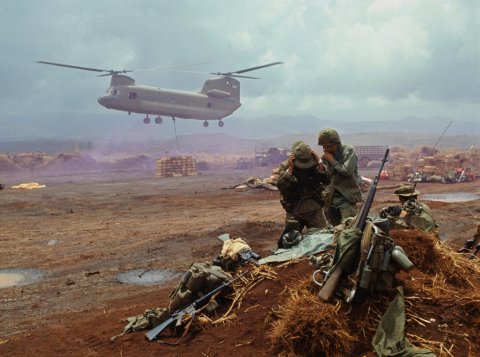
Since the late 1990s, American investigators have aggressively taken to Koh Tang with picks and spades, and they have recovered the remains of 13 men who died in the battle. But they say they failed to find those of Hargrove, Hall or Marshall. In 2008, investigators dug where Son claimed he had ordered Hargrove buried. Until recently, the Defense POW/MIA Accounting Agency (DPAA) wouldn't comment on exactly what they recovered there, but in a recent interview with Newsweek, they said they found only Cambodian bodies near the mango tree and fragments of animal bones where Hall and Marshall were allegedly beaten to death.
Turner, however, is skeptical about the agency's findings—and he isn't the only one. In recent years, DPAA has been embroiled in a series of scandals involving the remains of U.S. servicemen. One involved internal complaints that the agency had not properly recorded its work on Koh Tang in the search for Hall, Marshall and Hargrove. In fact, a Cambodian source—whose identity Newsweek is protecting because this individual is not authorized to speak to the press—strongly believes the body U.S. POW/MIA investigators removed near the mango tree in 2008 was an American. The remains were too tall to be Southeast Asian; the bones were long, according to the Cambodian source, and the Americans on the scene agreed. Charles Ray, the former U.S. ambassador to Cambodia and deputy assistant secretary of defense for POW/Missing Personnel Affairs, says U.S. government investigators told him as much. DPAA disputes this, saying its lab results proved otherwise, but the agency declined to provide proof of what it found to Newsweek or the Hargrove family.
In 2016, DPAA announced it had found Hall's ID card and personal items in an empty burial pit on Koh Tang. What it didn't publicly disclose, according to Newsweek 's Cambodian source, is that DPAA also found an American radio and a Marine flak jacket not far from where the last American chopper took off. The jacket had a name and a number in it. In an interview with Newsweek, DPAA officials acknowledged finding those items but declined to say to whom they belonged.
They also told me they had thrown away both the radio and the flak jacket.
Questions and Remains
Back in Florida, Standfast leaned forward on the edge of his chair, listening intently as the aging airman transported him back to that harrowing battle with the Khmer Rouge and explained why he had finally come forward with his story. Now in his 70s, Velie felt the need to unburden himself.
Standfast told me later that as he listened to Velie, he was mesmerized as one event spilled into the next. Velie spoke with authority, he said, without hesitation. He knew all the right acronyms and buzzwords and seemed of very sound mind. The former Marine had driven to Niceville a skeptic. Now, as Velie finished telling his story, he became a believer. "There's no way this was rehearsed," he said. "It was confirmation that they had been left on the island."
On their long drive home, Standfast and his wife discussed all that Velie had told them. He was happy to have learned the truth about that final, cryptic radio call. He isn't sure if it's enough to exorcise his ghosts, but it made him more determined than ever to help Hargrove's cousin find the remains of the Marines who got left behind.



